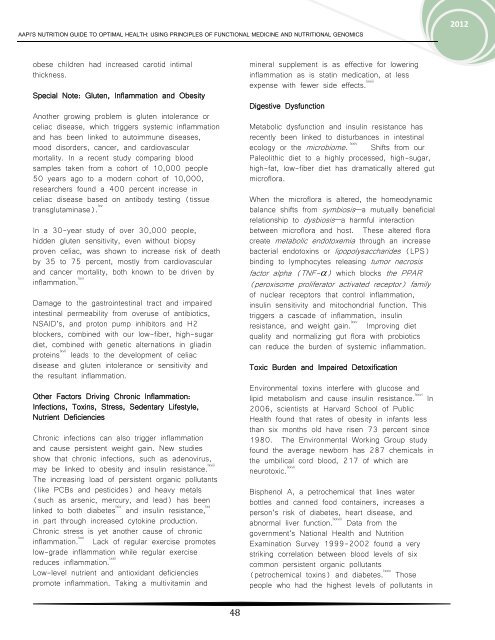functional medicine and nutritional genomics - American Association ...
functional medicine and nutritional genomics - American Association ...
functional medicine and nutritional genomics - American Association ...
Create successful ePaper yourself
Turn your PDF publications into a flip-book with our unique Google optimized e-Paper software.
AAPI’S NUTRITION GUIDE TO OPTIMAL HEALTH: USING PRINCIPLES OF FUNCTIONAL MEDICINE AND NUTRITIONAL GENOMICS<br />
obese children had increased carotid intimal<br />
thickness.<br />
Special Note: Gluten, Inflammation <strong>and</strong> Obesity<br />
Another growing problem is gluten intolerance or<br />
celiac disease, which triggers systemic inflammation<br />
<strong>and</strong> has been linked to autoimmune diseases,<br />
mood disorders, cancer, <strong>and</strong> cardiovascular<br />
mortality. In a recent study comparing blood<br />
samples taken from a cohort of 10,000 people<br />
50 years ago to a modern cohort of 10,000,<br />
researchers found a 400 percent increase in<br />
celiac disease based on antibody testing (tissue<br />
transglutaminase). lxv<br />
In a 30-year study of over 30,000 people,<br />
hidden gluten sensitivity, even without biopsy<br />
proven celiac, was shown to increase risk of death<br />
by 35 to 75 percent, mostly from cardiovascular<br />
<strong>and</strong> cancer mortality, both known to be driven by<br />
inflammation. lxvi<br />
Damage to the gastrointestinal tract <strong>and</strong> impaired<br />
intestinal permeability from overuse of antibiotics,<br />
NSAID’s, <strong>and</strong> proton pump inhibitors <strong>and</strong> H2<br />
blockers, combined with our low-fiber, high-sugar<br />
diet, combined with genetic alternations in gliadin<br />
proteins lxvii leads to the development of celiac<br />
disease <strong>and</strong> gluten intolerance or sensitivity <strong>and</strong><br />
the resultant inflammation.<br />
Other Factors Driving Chronic Inflammation:<br />
Infections, Toxins, Stress, Sedentary Lifestyle,<br />
Nutrient Deficiencies<br />
Chronic infections can also trigger inflammation<br />
<strong>and</strong> cause persistent weight gain. New studies<br />
show that chronic infections, such as adenovirus,<br />
may be linked to obesity <strong>and</strong> insulin resistance. lxviii<br />
The increasing load of persistent organic pollutants<br />
(like PCBs <strong>and</strong> pesticides) <strong>and</strong> heavy metals<br />
(such as arsenic, mercury, <strong>and</strong> lead) has been<br />
linked to both diabetes lxix<br />
<strong>and</strong> insulin resistance, lxx<br />
in part through increased cytokine production.<br />
Chronic stress is yet another cause of chronic<br />
inflammation. lxxi<br />
Lack of regular exercise promotes<br />
low-grade inflammation while regular exercise<br />
reduces inflammation. lxxii<br />
Low-level nutrient <strong>and</strong> antioxidant deficiencies<br />
promote inflammation. Taking a multivitamin <strong>and</strong><br />
48<br />
mineral supplement is as effective for lowering<br />
inflammation as is statin medication, at less<br />
expense with fewer side effects. lxxiii<br />
Digestive Dysfunction<br />
Metabolic dysfunction <strong>and</strong> insulin resistance has<br />
recently been linked to disturbances in intestinal<br />
ecology or the microbiome. lxxiv<br />
Shifts from our<br />
Paleolithic diet to a highly processed, high-sugar,<br />
high-fat, low-fiber diet has dramatically altered gut<br />
microflora.<br />
When the microflora is altered, the homeodynamic<br />
balance shifts from symbiosis—a mutually beneficial<br />
relationship to dysbiosis—a harmful interaction<br />
between microflora <strong>and</strong> host. These altered flora<br />
create metabolic endotoxemia through an increase<br />
bacterial endotoxins or lipopolysaccharides (LPS)<br />
binding to lymphocytes releasing tumor necrosis<br />
factor alpha (TNF-�) which blocks the PPAR<br />
(peroxisome proliferator activated receptor) family<br />
of nuclear receptors that control inflammation,<br />
insulin sensitivity <strong>and</strong> mitochondrial function. This<br />
triggers a cascade of inflammation, insulin<br />
resistance, <strong>and</strong> weight gain. lxxv<br />
Improving diet<br />
quality <strong>and</strong> normalizing gut flora with probiotics<br />
can reduce the burden of systemic inflammation.<br />
Toxic Burden <strong>and</strong> Impaired Detoxification<br />
Environmental toxins interfere with glucose <strong>and</strong><br />
lipid metabolism <strong>and</strong> cause insulin resistance. lxxvi<br />
In<br />
2006, scientists at Harvard School of Public<br />
Health found that rates of obesity in infants less<br />
than six months old have risen 73 percent since<br />
1980. The Environmental Working Group study<br />
found the average newborn has 287 chemicals in<br />
the umbilical cord blood, 217 of which are<br />
neurotoxic. lxxvii<br />
Bisphenol A, a petrochemical that lines water<br />
bottles <strong>and</strong> canned food containers, increases a<br />
person’s risk of diabetes, heart disease, <strong>and</strong><br />
abnormal liver function. lxxviii<br />
Data from the<br />
government’s National Health <strong>and</strong> Nutrition<br />
Examination Survey 1999-2002 found a very<br />
striking correlation between blood levels of six<br />
common persistent organic pollutants<br />
(petrochemical toxins) <strong>and</strong> diabetes. lxxix Those<br />
people who had the highest levels of pollutants in<br />
2012

















